
Miramichi June Salmon News
In retrospect there was mixed news on the Miramichi spring fishing this year. On the good side were reports of solid numbers of large salmon – something that I can vouch for myself – and that speaks well for last fall’s spawning. There were also better numbers of 1 to 3 pound sea run brook trout than in most recent springs.
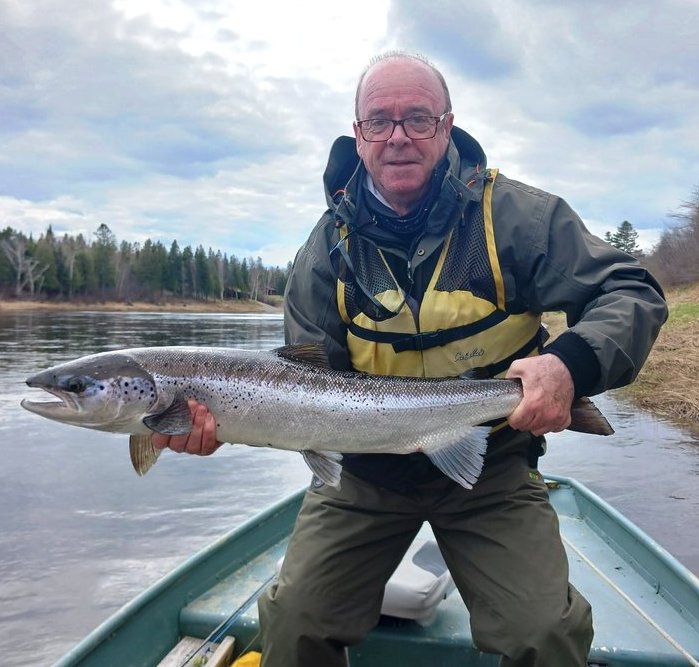
Tony Spratt from England fishes the Miramichi several times each year. This kelt was caught lower down in the SW Miramichi and is clearly in great shape and nearly ready to head back to sea.
Byron Coughlan of Country Haven reported the increased catches and said that he hoped that maybe the trout were learning to cope with the incredible numbers of bass. One positive thing about the trout situation is that only a small percentage of brook trout head down stream to become sea runs. The whole Miramichi system is fed by brook trout streams, so in that regard there is a large and consistently available spawning biomass of Miramichi brookies to potentially become sea runs. The salmon aren’t quite that lucky, as all young salmon that survive to smolthood have to run the striper gauntlet.
Grilse numbers were down in the spring salmon catch. For the vast majority of my years spring salmon fishing on the Miramichi grilse outnumbered salmon by several to one. Not this year. I noticed while I was in camp at the beginning of the season that about one in every three or four fish was a grilse. In general anglers, guides and lodge owners I spoke with expressed this same experience.
Why would this be? First, while last year’s salmon numbers were up over the previous year, the grilse run was weak at only about 50% of the returns in 2021. 2021 was one of best recent grilse years. Looking at the average trap efficiencies the number of returning salmon and grilse for 2022 were roughly equal. Winter survival of grilse is also known to be lower than salmon, though last year’s easy winter should have helped mitigate that. Still, all these factors don’t seem to completely explain two or three salmon to every grilse.
So why are grilse numbers down more than salmon? There seem to be two possible scenarios. The first is the bass are eating so many outgoing smolts that you see the results clearly in the reduced number of adults that come back as grilse after just one year at sea. In the case of salmon the numbers are somewhat blunted by the added attrition of a second year spent in the ocean – no matter how large the difference in year classes may be, the total surviving from each gets closer in number with every passing year. Also, salmon numbers include repeat spawners which by their size are probably better able to survive the rigors of life at sea.
Finally, it may be important to understand that by some counts prior to about 1966 there were more salmon than grilse in the annual rod catch. This was very clearly shown over 30 years of fishing in the records of Seabury Stanton’s lodge on the Cains River. What caused this? It was very likely the Greenland fishery which was then just beginning. While the Greenlanders are still taking a lot more salmon than they should – the number should be zero in this mixed stock fishery – it is a small fraction of the numbers that were taken back in the late 60s and 70s. Perhaps with the reduced Greenland catch the Miramichi population is moving back into the direction of more salmon than grilse.
There have been a number of bright salmon caught so far on the Miramichi, though all catches that I have heard of so far were on the NW branch. The NW has always been known as the earlier run river. Last weekend Jeff Curtis caught a nice salmon and I got an e-mail from another angler who said he witnessed a bright fish being caught also on the NW branch. I assume this is the tip of the iceberg, and that there were more. I do know of salmon being seen jumping on the SW, and doubtless some have been caught that escaped any fanfare. The full moon is today, June 3, and that could mean that the accompanying higher tides and recent rain should bring in some increasing numbers of bright salmon.
In recent years the early run has been stronger relative to the total run. For instance, through June 30, 2022 the number of salmon in the Millerton trap was a minimum of 50% greater than any other period from 1999 onward – and the second highest year was 2021. Who knows why this is. According to Mark Hambrook who followed these things for years, the strength of the run has always fluctuated between summer and fall, and for no apparent reason.
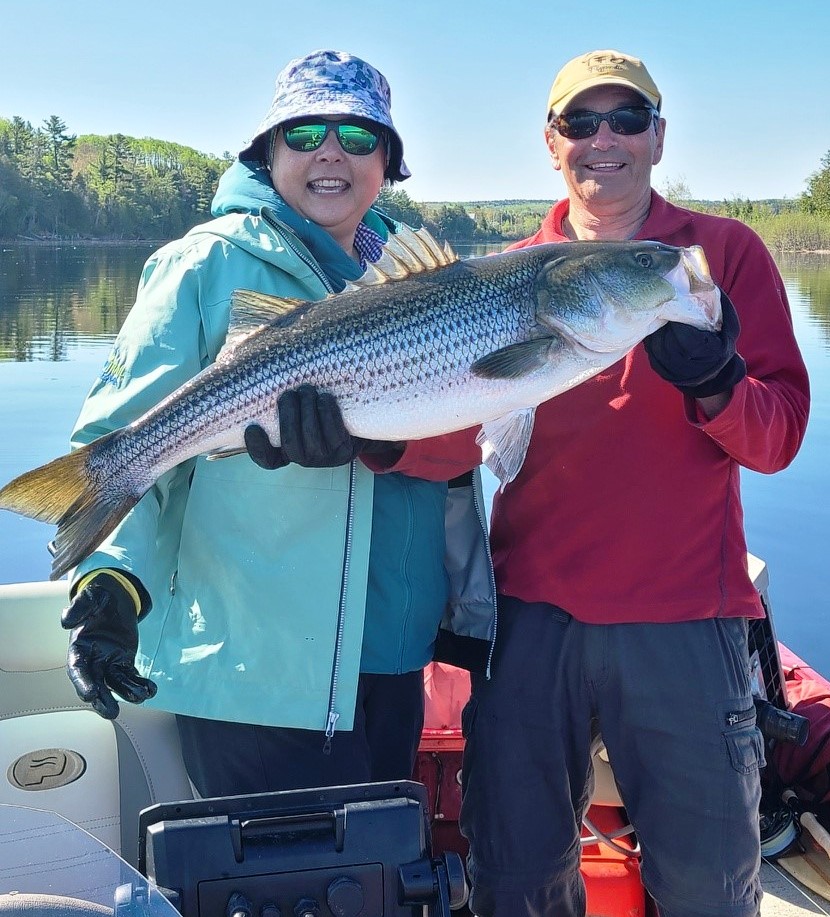
Debbie Norton of Upper Oxbow sent this photo of one of her guests with this 36″ bass. We can realistically say that it is one in a million…
Everyone has probably seen the videos like this one from the ASF Rivernotes https://vimeo.com/831331220?embedded=true&source=vimeo_logo&owner=36356433 that shows the insane numbers of striped bass that have literally taken over the NW Miramichi during late May. How the Canadian Department of Fisheries and Oceans “DFO” can apparently have chosen to create a situation where the striper population so dominates the whole river system is a very in-depth question, but they have clearly done it, and in fact, as the ASF pointed out in their recent River Notes, DFO strengthened the striped bass spawning area protections for 2023. It is clear that they have no thought of doing anything to balance the striper population with that of Atlantic salmon, smelts, shad, herring, sea run brook trout, or any other species that I may have missed that lives in the river.
To this scenario there are three mitigating actions that I can see:
- Send more smolts down the river so that more escape to the estuary than currently do.
- Reduce the number of striped bass in the river back to something more approximating a historical relationship between salmon and bass. This would be accomplished by more generous size and bag limits and a commercial fishery open to more than just FN participants.
- Find a way to help the smolts make it by the bass alive – there are ways.
So far the DFO has refused to allow stocking more fry in the river, though efforts do continue to try to change their mind on that front. We already addressed the refusal of DFO to reduce striper numbers, though that too can change.
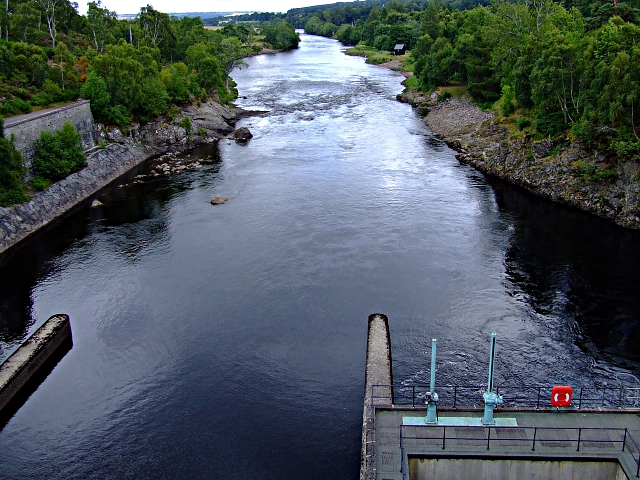
One of the River Conon hydro developments in Scotland that require smolts be trucked downstream to avoid excessive mortality.
There is a program going on now on the Spey River in Scotland to “shepard” smolts around an area of that river where they too are experiencing high levels of smolt mortality. It isn’t the first time that such techniques have been used. During the 1950s and 60s the River Conon in NE Scotland was dammed in several locations for hydro power. To get the salmon downstream around the dams smolts are gathered up and trucked around the dams. I have read that a segment of these trucked smolts have been tagged, and that 4% return to the river as adult salmon. That is a higher percentage than currently return to the Miramichi in most years.
It is important to note that the dams on the Conon also greatly reduced the viable spawning area of the river. Despite the dams the Conon has continued to provide a very good Atlantic salmon fishery. All of the Miramichi’s ultra-extensive spawning areas have survived and are still productive. Given a little flexible thinking we should be able to weather this striped bass onslaught. Mother nature may help us too. Striped bass spawning success has historically been highly variable. During the 1990s the Chesapeake Bay spawning grounds produced striped bass young of the year counts as high as 60, but they have been under 2 recently for several years in a row. The bass went through a similar population crash in the early 1980s and have at other times historically.
Next Saturday, June 10, I will be moving up to Campbell’s Pool in Blackville for the next month of fishing. I have been keeping up with my daily Salmon Reports since the season opened on April 15. Beginning on the 11th, though, I will add first-hand reporting on the salmon run to the information that I gather through my contacts on the river. Add the Salmon Reports link to your favorites and stay in touch. Note that you can also comment on the reports and send me questions at bigbass@maine.rr.com anytime.
Thanks for reading. Brad Burns


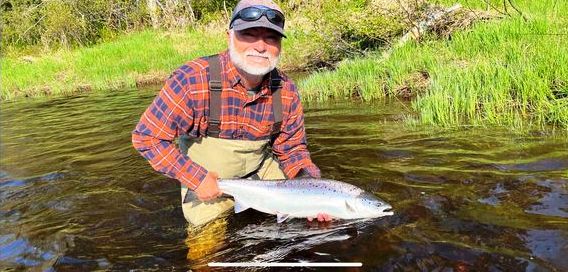

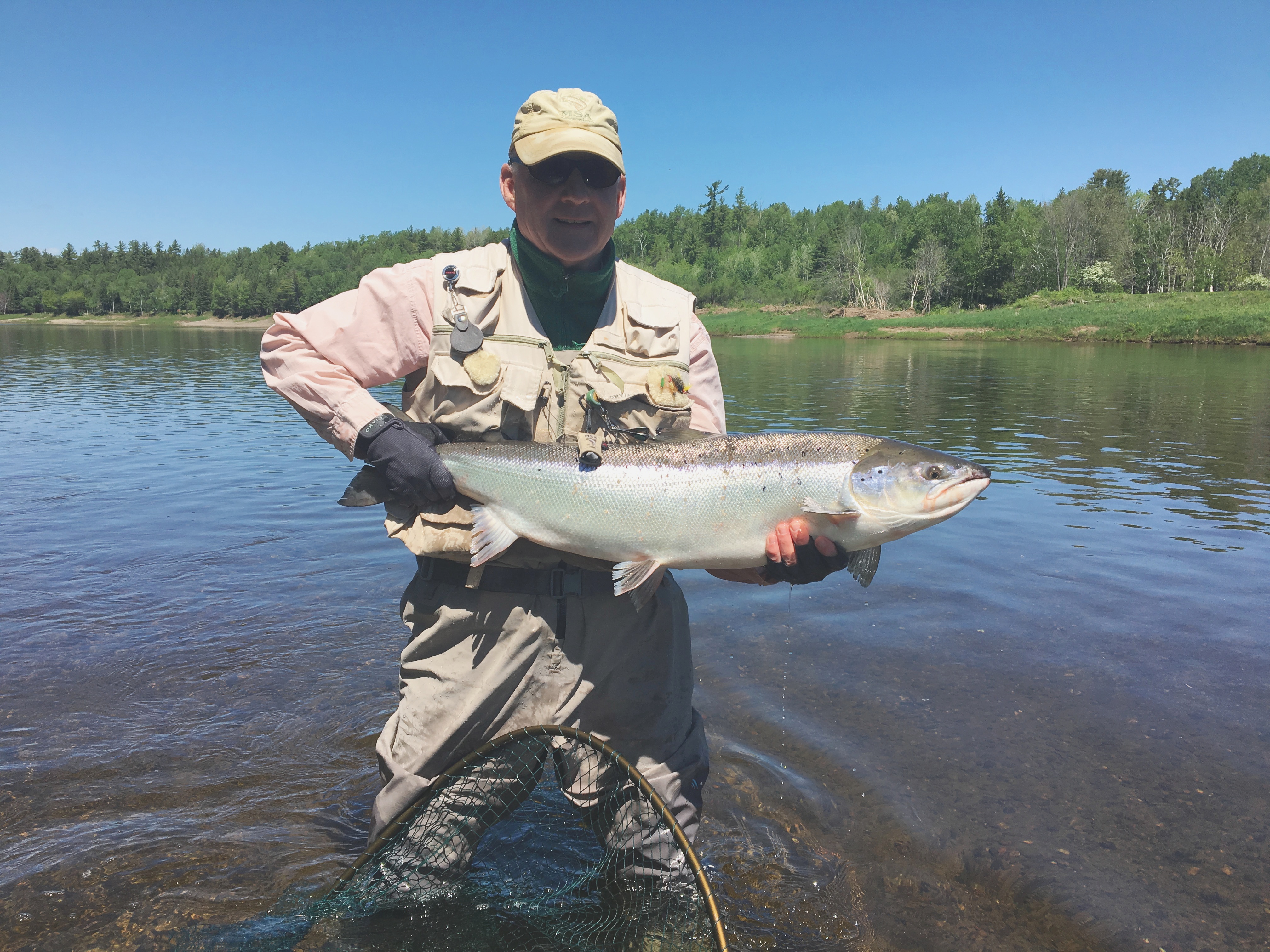
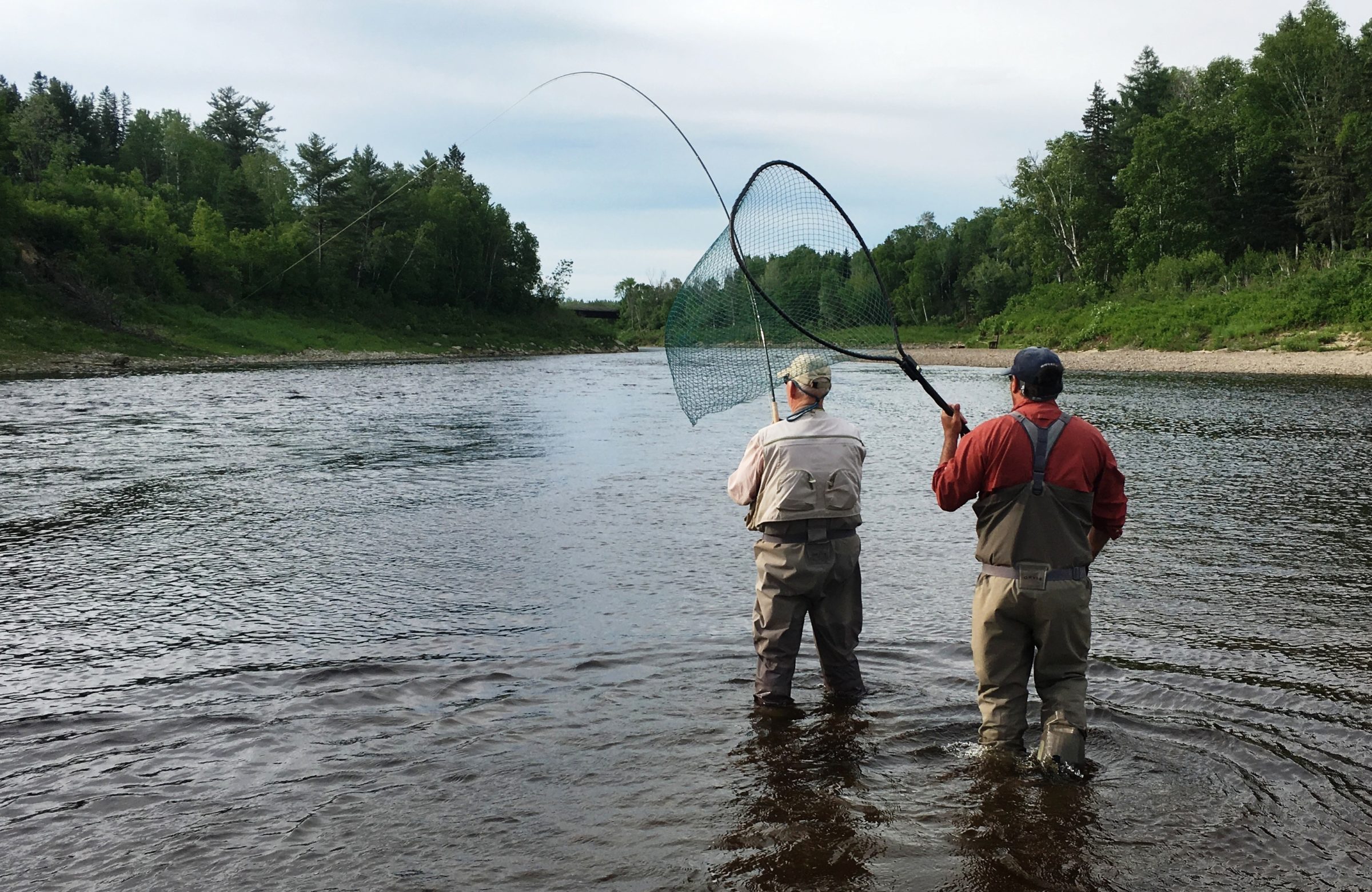
Always a great read Brad … thanks for your undying commitment to the Atlantic Salmon fishery!
Thanks Ian. If there was ever anything in life I’ve ever found that was worth fighting for it would be the Miramichi River Atlantic salmon population.
Thanks for the information as always Brad! It’s finally time for my long-awaited trip to Country Haven on June 20th with my two sons. As I may have mentioned previously the last time I fished the Miramichi for salmon was in 1963, yup, 60 years ago, at the ripe old age of 11. I caught a grilse back then and hope to get another picture holding a salmon to put with that one in a couple of weeks. As you can probably imagine, I am beyond excited about my upcoming trip!
Thank Brad. Again very informative.
Thanks James. Looking forward to seeing some salmon.
Thank you, Brad. I look forward to reading your reports when you get back to camp.
I can’t wait to get up there and start writing them.
Very informative as always especially for a novice fly fisher. 👍🍀🍻🎣🫎🦞
You’re welcome.
Brad, I was horrified by the recent video sent out by the ASF, showing millions of small mouth bass spawning in the St Lawrence. I think we all realize that if something isn’t done to get rid of both stripers and small-mouth bass, then the Atlantic salmon fishery in the Miramichi, and in other great salmon rivers, is doomed. So, what can we do to put pressure on DFO to do something about it?
“So far the DFO has refused to allow stocking more fry in the river” This is the statement that I can’t shake. What would the reason be? With salmon numbers at historic lows on the Miramichi, you would think that it’s time to pull out all stops and to try any program that could increase or at least maintain the current numbers. Our salmon have been on the decline for decades now, but the drop since 2011 is at the crisis level. Increase the number of fry, capture some smolts and truck them past the ‘pinch point’ as you described it in an earlier article, perhaps go back to the SAS Program with a percentage of the smolts, and have no limit on the number or size or stripers that can be retained above the tide heads. At least then we’d feel like an effort was being made to help our world renown salmon river.
Bob – let me say that I too simply can’t believe DFO’s response to the Miramichi situation. I can tell you, though that there seems to be a great divide in the salmon science community with those on one side who are totally against all kinds of stocking unless the native population is extinct, and those who see well thought out stocking as a sensible tool with which to mitigate other problems- like poor ocean survival and unnatural levels of predation. One very prominent NB scientist has said that there is no scientific justification for the first position, just personal bias. I completely agree. Brad
DFO no longer should have say on our river with the terrible decisions they’ve made past two decades! Stocking needs to be done at a massive rate Every river branch and stream in the system should be filled with millions of fry more fish we put out more will come back if the bass numbers was at a sensible population it be very interesting how many salmon we would have but when the smolts are not getting out of the estuary because of the outrages numbers of bass it’s hard for us to have good numbers of returns!
We also need to realize we still are lucky on the Miramichi that we still have a good salmon run compared to many places that barely have any fish left and with some help such as stocking and management of predators we can get back out great numbers to what we used to have but action needs to be taken ASAP
Couldn’t agree more. Brad
Hi Brad
I’m visiting Country Haven for a weeks fishing starting June 18.
I live in UK and this is my first time to Miramichi, do you have any advice please on flies, lines, methods, etc to use ?
We usually fish in Scotland and Norway for salmon from July to October
I know river conditions will affect your answer and see it is raining this week and forecast dry and warm next week
Regards
David Searson
Thanks for the update, Brad. I appreciate your reports on the Striped Bass situation. I’m still at a loss of why DFO doesn’t see this over population of Bass impacting the Salmon population and be willing to do something about it.
Denny – I don’t think DFO understands the value of the salmon fishery. Their culture is all marine fish. The best answer would be to have the Province take over salmon management. Maybe they will eventually. Brad